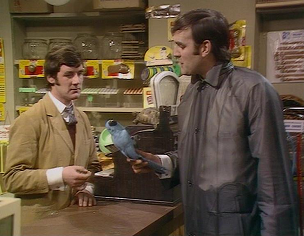Small beer at Stodmarsh and dipping at Dungeness
When the first tinges of autumn touch the early morning air, the expectations of increasing my British tick list grow. September and October are always full of promise and it is with an extra energy and enthusiasm that I venture out in the dimly lit morning.
There are so many good places to go birding that the choice can sometimes be a bad thing. Do I go to Norfolk (again) for an arctic warbler or do I go to Hampshire for an Isabelline shrike? No, I thought, I’d go to sunny Kent for a Wilson’s phalarope. I suppose, I just like the word, Phalarope. It reminds me of something the Monty Python team would use to great effect, especially if it was dead.
 |
| The dead Phalarope sketch. |
I got to Grove Ferry, which is northeast to Stodmarsh but pretty much the same thing. The phalarope had been seen the evening before from a vantage point known as the viewing ramp and as I approached the ramp, I could see at least 5/6 birders already scoping the water. Was it there? I asked hopefully. Not been seen yet was the reply. Okay so it was only 7am and the bird had been seen on other parts of the reserve so all was not lost…yet.
 |
| The Grove Ferry Inn. I even dipped this. |
After about 2 hours, I’d had enough of the waiting and decided to look around the reserve and hope that someone found the phalarope quickly.
In the first hide, I found some common snipe with a couple of green sandpipers. A pair of spotted redshanks gave close views along with a few black-tailed godwits. Around the Harrison Drove hide a few birders had found four whinchats and a wheatear all together on one bush but too far away to photograph. From the hide, there was nothing to see apart from a few lapwings in the distance.
I headed back to the viewing ramp but the phalarope still hadn’t appeared – had no one bothered to tell it? With many people giving up and only cetti’s warbler and sedge warbler to watch as they fed on elderberry beside the ramp, I resigned myself to a serious dip. A dip is what you call it when a ‘good’ bird is either missed or just wasn’t there to see. Oh well, Dungeness would help sooth the pain. Wouldn’t it?
Funny place Kent. My satNav took my through some laughable places on the way to Dungeness. Wickhembreaux (sounds like a French cheese), Patrixbourne (sounds like a birth announcement) Breach (ditto), Bladbean (just stupid) and of course The Lyminge Forest (answers on my blog please…on second thoughts)
 |
| I could live here. |
 |
| Prospect Cottage |
 |
| Black Tern |
 |
| Wheatear |






Comments
Post a Comment